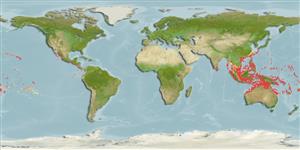>
Acanthuriformes (Surgeonfishes) >
Acanthuridae (Surgeonfishes, tangs, unicornfishes) > Acanthurinae
Etymology: Acanthurus: Greek, akantha = thorn + Greek, oura = tail (Ref. 45335).
More on author: Linnaeus.
Environment: milieu / climate zone / depth range / distribution range
Écologie
marin récifal; profondeur 0 - 67 m (Ref. 1602), usually 2 - 67 m (Ref. 27115). Tropical; 21°C - 29°C (Ref. 27115); 30°N - 24°S
Eastern Indian Ocean: known only from Cocos-Keeling Islands and Christmas Island. Pacific Ocean: Ryukyu Islands and Great Barrier Reef to the Hawaiian Islands and French Polynesia (excluding Rapa). This species has crossed the Eastern Pacific Barrier to the Revillagigedo Islands, Cocos Island, Galapagos Islands, and the coast of Mexico.
Taille / Poids / Âge
Maturity: Lm ? range ? - ? cm
Max length : 36.0 cm FL mâle / non sexé; (Ref. 125599); poids max. publié: 620.00 g (Ref. 125599); âge max. reporté: 34 années (Ref. 52229)
Épines dorsales (Total): 9; Rayons mous dorsaux (Total): 28-31; Épines anales 3; Rayons mous anaux: 26 - 28. A horizontally elongate white blotch directly below eye. No orange band in outer part of dorsal fin. Caudal peduncle black except for yellow edge of socket and sheath of peduncular spine. Base of pectoral fin black (ref 9808).Gill rakers on anterior row:17-19, on posterior row:18-20.
Adults inhabit hard substrate areas of clear lagoon and seaward reefs from the lower surge zone to at least 67 m and feeds on filamentous algae. Solitary or in groups (Ref. 90102). Monogamous (Ref. 52884, 48637). Benthopelagic (Ref. 58302). Small juveniles shy among large corals (Ref. 48637). Territorial species. Common throughout Micronesia and hybridizes with the rare A. achilles. Size of metamorphosis from the postlarva stage to juvenile is 5.5 to 6 cm (Ref. 9267). Minimum depth reported taken from Ref. 128797.
Life cycle and mating behavior
Maturité | Reproduction | Frai | Œufs | Fécondité | Larves
Monogamous mating is observed as both facultative and social (Ref. 52884).
Myers, R.F., 1991. Micronesian reef fishes. Second Ed. Coral Graphics, Barrigada, Guam. 298 p. (Ref. 1602)
Statut dans la liste rouge de l'IUCN (Ref. 130435)
Menace pour l'homme
Harmless
Utilisations par l'homme
Pêcheries: pêcheries vivrières; Aquarium: Commercial
Plus d'informations
RéférencesAquacultureProfil d'aquacultureSouchesGénétiqueElectrophoresesHéritabilitéPathologiesTraitementNutrientsMass conversion
Outils
Articles particuliers
Télécharger en XML
Sources Internet
Estimates based on models
Preferred temperature (Ref.
123201): 24.5 - 28.8, mean 27.4 °C (based on 650 cells).
Phylogenetic diversity index (Ref.
82804): PD
50 = 0.5000 [Uniqueness, from 0.5 = low to 2.0 = high].
Bayesian length-weight: a=0.02630 (0.01489 - 0.04645), b=2.93 (2.78 - 3.08), in cm total length, based on LWR estimates for this species & Genus-body shape (Ref.
93245).
Niveau trophique (Ref.
69278): 2.0 ±0.00 se; based on food items.
Generation time: 3.9 ( na - na) years. Estimated as median ln(3)/K based on 2
growth studies.
Résilience (Ref.
120179): Milieu, temps minimum de doublement de population : 1,4 à 4,4 années (K=0.28; growth and reproduction as expected for Medium; tmax=34 observed only in deep water (RF)).
Fishing Vulnerability (Ref.
59153): Low vulnerability (23 of 100).
Nutrients (Ref.
124155): Calcium = 79 [33, 233] mg/100g; Iron = 0.872 [0.331, 2.159] mg/100g; Protein = 18.1 [16.8, 19.3] %; Omega3 = 0.116 [0.053, 0.246] g/100g; Selenium = 19.6 [6.8, 61.6] μg/100g; VitaminA = 42.5 [9.8, 174.9] μg/100g; Zinc = 3.14 [1.00, 5.83] mg/100g (wet weight);
